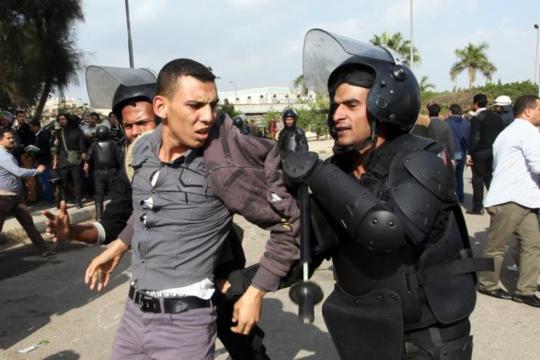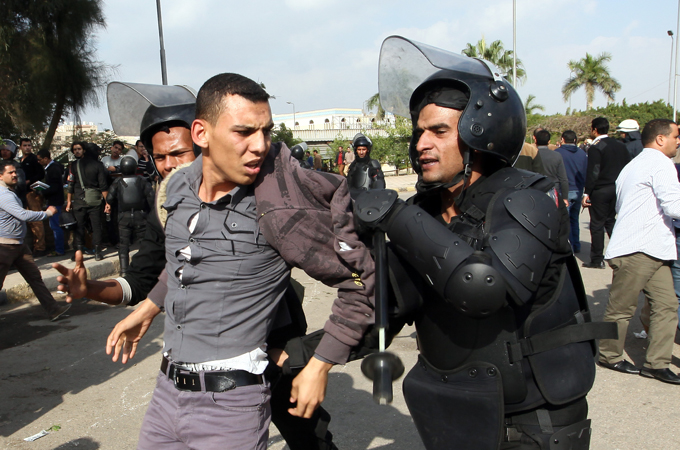
 |
| Egyptian security forces subdue peaceful protests post-coup [Associated Press] |
| Abstract A string of armed attacks on military personnel and buildings in cities of the Nile Valley and Sinai Peninsula are not surprising given the Egyptian army’s past and present crackdown on villages and communities in northern Sinai. This paper examines armed attacks on these areas, questions why and how armed attacks reached the Valley, explores actors behind the attacks and projects what these attacks mean for Egypt’s security and political future. |
Introduction
Armed violence in Egypt, fuelled by the current regime’s acts of injustice, indicates that armed attacks could extend beyond the regime’s control. While armed attacks will not depose the current regime, it is difficult for the state to quickly and decisively defeat these armed attackers, creating further instability in the country. Examples include five dead soldiers in an attack late January on an Egyptian military outpost in Bani Sweif, four dead and 51 wounded in a car bomb in front of Cairo’s police headquarters, the assassination of aide to the interior minister General Mohamed Saeed on January 28, 2014 and an attack on a church in 6th of October City on the same day in which a security officer was killed. Similar attacks have been taking place since last summer – particularly in cities in the Nile Valley and the Sinai Peninsula, considered a stronghold for armed and radical Islamist groups since the 1990s. Such attacks do not come as a surprise because the Egyptian army has forcefully suppressed villages and communities in northern Sinai since the July 3, 2013 coup. This paper examines attacks in these areas, questions why and how armed activities reached the Valley, explores actors behind the attacks and projects what these attacks mean for Egypt’s security and political future.
Assigning blame for attacks
As with any standoff as a result of armed conflict, two Egyptian perspectives have emerged over the past month on the wave of violence in the country.
The state’s official rhetoric has been that it is dealing with terror attacks on the state and its resources. Adly Mansour, interim president, announced on January 26, 2014 that the state can and will defeat and stop terrorism just as it did in the 1990s, taking all necessary measures to achieve this goal. State agencies and state-run media outlets are striving to lay blame on Islamist groups opposing the regime, particularly the Muslim Brotherhood.
Media outlets, including those loyal to the regime, have been banned by the regime from covering operations in Sinai for more than six months. Names of suspects are announced only for later revelations to emerge that the suspects have been imprisoned for months or are dead. In the case of several Palestinians accused of attacks on the Egyptian military, it later emerged that they were killed some time ago or have been incarcerated in Israeli prisons for years.
Many opposition powers, including the National Coalition to Support Legitimacy (NCSL), say the inaccuracies are evidence that the attacks are nothing more than operations planned and supervised by official security bodies. They claim the regime’s goal is to create a climate of fear and terror among Egyptians, arguing that this will sanction policies and procedures that would not be imposed in a secure environment. The current regime’s “war on terror” invokes support from the international community, particularly western powers who claim to be waging the same fight. The opposition further states that the use of these armed and violent incidents are designed to discount the opposition’s attempts to engage peacefully using political and civil action – in fact, it is a tactic used by the regime because it has been unable to break or contain the opposition’s popular movement.
There is a real possibility that armed attacks outside of the Sinai Peninsula were indeed planned by security agencies, similar to the Mubarak regime’s planned explosion of a church to stir up religious animosity. The question of benefits then arises – if observers are able to pinpoint who is benefitting from these attacks, this could offer an explanation for the violence.
On the one hand, the regime is benefitting from the violence – it is an excuse for it to lay blame on the NCSL. The Dakahlia police station explosion was used by the regime as justification to ban the Muslim Brotherhood (MB) and classify it as a terrorist organization. The regime, however, has been unable to provide conclusive evidence that the Brotherhood was responsible. Furthermore, the Brotherhood continues to condemn these armed attacks and call for a peaceful solution.
On the other hand, these attacks exemplify the regime’s inability to maintain safety and security in the country, reaffirming that Egypt has lost its stability and subsequently much of its tourism and investment business from Egyptians and foreigners alike. After months of waiting for a political solution, groups and families have also been seriously affected by the army and security forces’ clear disregard for human rights in their treatment of the opposition since July 2013. These armed groups that existed before the coup of July 3, 2013 may have become more willing to target the military and police in the last seven months in retaliation for the regime’s human rights abuses.
Ansar Bait al-Maqdis and other actors
Ansar Bait Al-Maqdis is a prominent group claiming responsibility for several of the recent operations in the Sinai Peninsula. The NCSL claims this group is an invention of the state’s security apparatus, while state-run media claim the group was founded and funded by Muslim Brotherhood leader and engineer Khairat Al-Shater before the July 3 coup as a militant arm of the party. There is no evidence to support either accusation.
In the 1980s, Islamic activism began to appear among civilians and in Bedouin communities, manifesting in three main organizations: Al-Tawhid wal Jihad, Al-Tabligh wal Dawah and Dawat Ahlu Al-Sunnah wal Jamaa. Mubarak’s regime cracked down after tourist resort attacks claimed by these groups, resulting in a campaign of suppression that fuelled anger in Sinai communities and reinforced radical trends among young Islamists.
In the early 2000s, Islamist groups in Sinai were fractured and some disappeared completely, but four new organizations were born. They were the Mujahideen Shura Council in the Environs of Jerusalem, the Jihadi Salafists, the Soldiers of Islam and Ansar Bait Al-Maqdis and had no apparent tendencies to attack army and security forces, instead devoting their efforts to attacking Israelis across the border or their agents in northern Sinai. These attacks began before the 2011 revolution, continuing throughout the Supreme Council of the Armed Forces (SCAF) and President Morsi’s eras.
Videos released on social media by the Ansar Bait Al-Maqdis group in 2012 allude to links to Abu Musab Al-Zarqawi, founder of Iraq’s Al-Qaeda branch, and Abu Muhammad Al-Adnani, official spokesman of the Islamic State of Iraq and the Levant (ISIL).While this does not mean Ansar Bait Al-Maqdis is an extension of Al-Qaeda or ISIL, it indicates the group has been influenced by their teachings and rhetoric.
Membership in the group is not limited to the Sinai Peninsula, nor is its operational capabilities. Some members are from the area, while others are Islamist radicals who sought refuge in northern Sinai in order to escape Mubarak’s security forces years back. In a string of continuing violence, several explosive devices have been planted in police cars, while others have been targeted with Molotov cocktails across the country – and speculations are that these incidents are carried out by local agents not part of a larger organization, but rather born out of local formations (distinguishing themselves from the NCSL) which oppose the coup and suppression by security forces.
Consequences and Egypt’s security and political future
While the interim president compared stamping out 1990s terrorism in Egypt to stamping out current attacks, 21st century Egypt is simply different than Egypt in the 1990s. It is similar to the situation in which Syria finds itself three years after the start of its revolution. For more than six months, the Syrian revolution was mostly peaceful, although the regime attempted to weave a narrative of an armed Salafist rebellion, using it as an excuse to battle “terrorism.” There is even evidence the Assad regime put great effort into arming the rebellion, believing that this would be a successful end to the popular movement. However, events quickly spiralled out of control, and the Assad regime could no longer keep track of the movement of arms, defeat the increasing number of armed groups or stop defections in its army’s ranks.
Egypt is headed towards a similar environment of wide-spread armed conflict and violence, counter-violence and a lack of stability and security, pushing its economic and financial situation closer to the brink of instability. Because Egypt is larger, more complex and potentially more complicated than Syria, this could result in a disaster even greater than that of Syria. The current Egyptian regime’s claims that it can and will defeat terrorism like it did in the 1990s is doubtful given the differences between that movement and today’s armed groups.
Violence in the 1990s had no popular support nor did it have the approval of the people. The group that took up arms in the 1990s had an Islamic identity, but Islamic powers in the country such as the Muslim Brotherhood did not endorse them. Leaders of those past armed groups were put down by swift death or incarceration, causing major disturbances in their ability to continue networking and moving forward. Today’s situation is different – popular frustration and anger at the regime’s injustice is a base and incubator for such violence. It is difficult to judge the vastness of the armed approach today as opposed to the easily identifiable one of the past, making a quick and conclusive defeat of such groups very difficult for the current regime. If the situation continues in this manner, this will lead to a long and painful era of violence and despair in Egypt.